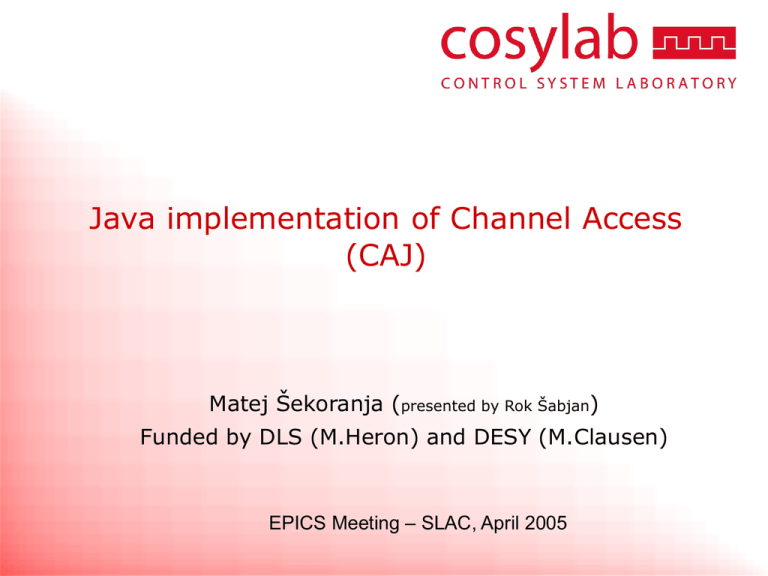Java implementation of Channel Access (CAJ) Matej Šekoranja ( )
advertisement

Java implementation of Channel Access (CAJ) Matej Šekoranja (presented by Rok Šabjan) Funded by DLS (M.Heron) and DESY (M.Clausen) EPICS Meeting – SLAC, April 2005 What is CAJ? • Channel Access in Java (CAJ) is a CA client library written completely in Java • It “plugs” into JCA 2 interfaces • Written as a result of detailed analysis of existing CA library to provide better stability and performance opposed to the current JCA JNI implementation • Since it was written from scratch code is clean, follows OO design and uses lots of design patterns • No problems with native libraries (no recompilation needed) Achieving stability • The main reason CAJ was written is stability - JCA JNI was not hard to crash with our ControlDesk application for the DLS (extensive concurrent connect, monitor creation and value retrieval) • Profound testing during the whole development cycle • ~ 90% of code coverage! • Code simplicity helped a lot (simple code leads to less bugs) • ‘TCP Reno’-like UDP congestion control • Until now “only” 4 CAJ bugs were discovered •2 by Ken Evans Achieving performance • Latest concurrent, network communication design patterns used to implement efficient event demultiplexing, minimize context switching and maximize CPU cache affinity (Leader/Followers design pattern used) • Asynchronous I/O used (Java NIO package) • new epoll-based selector supported, which is improved select(); available in the latest Linux 2.6 kernel • (Some performance measurements will be shown later) • Due to OO design light CAJ version is possible (one communication thread), convenient for light CA clients (handhelds) Immediate JCA JNI to CAJ migration Simply change (example): jca.createContext(JCALibrary.JNI_SINGLE_THREADED); OR jca.createContext(JCALibrary.JNI_THREAD_SAFE); jca.createContext(JCALibrary.CHANNEL_ACCESS_JAVA); … and take care of configuration. Note that CAJ can not use system environment variables like EPICS_CA_ADDR_LIST (not available in Java 1.4, but available again in Java 1.5). OO Usage of JCA Performance measurements • Client on the same host as server, Pentium IV 1.6GHz, 1GB RAM, Red Hat 9 •"no bulk" means calling flushIO() after each get request CAJ vs. JCA JNI/ThreadSafe comparison 5000 Time to get all responses [ms] 4500 4000 3500 3000 2500 2000 1500 1000 500 0 10000 sync get-s 10000 async get-s CAJ 10000 (no bulk) sync gets 10000 (no bulk) async. get-s JNI Note: this is only synthetic performance test and doesn’t reflect performance in practice! Comparing to C Version of CA • Completely different approaches: • C pointer versus Java object creation • Java is clean, C is dirty but quick • Based on CA 4.11, should be compabitle down to 4.0 • But has not been tested • Backward compatibility might be an issue • several undocumented features in the C version, might have missed one User Experiences • Control Desk • was limited to some 300 PVs before • JoiMint • just got ported to JCA 2 so it can use CAJ • JProbe (Ken Evans ported it to JCA 2). • “I have tested it on all the dbr types. Like my performance test, it is an application that requires a large subset of the features provided by CA. I think CAJ is looking good.” • “Moreover, my test program, which accesses 100 PVs updating at 10 Hz, worked *much* better. Before, there were dropouts. Now, it seems to keep up. Cool!” Conclusions • Needs some time (production usage) to confirm maturity • JCA still has much room for performance improvements, now that JNI isn’t the bottleneck anymore • Open possiblities for more user friendly applications based on Java •develop a CAJ server to integrate other Java Applications? • Proves that • other-than legacy CA implementation can be done … • CA documentation is useful and useable and that CA is not something mysterious • Cosylab needs a new task (and funding )


